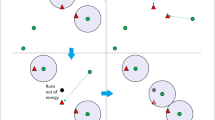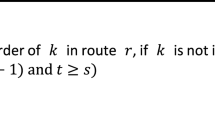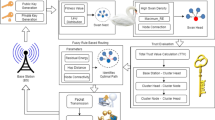Abstract
In this paper, we focus on the non-existence of isolated nodes in secure wireless sensor networks under full visibility condition. Here, we consider a sensor network with n sensor nodes distributed uniformly over a compact space \(C \subset {\mathbb {R}}^2\). We establish a threshold for the proportion of key ring and key pool size; above this threshold isolated nodes disappear from the network almost surely. We derive that for key pool of size \(cn\log \,n\) and key ring of size \(c\log \,n\) (of an arbitrary node) and \(c>2\) there will be no isolated nodes in the network almost surely.



Similar content being viewed by others
References
Perrig, A., Stankovic, J., & Wagner, D. (2004). Security in wireless sensor networks. Communications of the ACM, 47, 53–57.
Camtepe, S. A., & Yener, B. (2005). Key distribution mechanisms for wireless sensor networks: a survey, Computer Science Department at RPI, Tech. Rep. TR-05-07.
Eschenauer, L., & Gligor, V. D. (2002). A key-management scheme for distributed sensor network. In Proceedings of the 9th ACM conference on computer and communication security, Nov 2002.
Sun, D. M., & He, B. (2006). Review of key management mechanisms in wireless sensor networks. Acta Automatica Sinica, 12, 900–906.
Chan, H., Perrig, A., & Song, D. (2003). Random key predistribution schemes for sensor networks. In Proceedings of the 2003 IEEE symposium on security and privacy, May 2003.
Erdos, P., & Renyi, A. (1960). On the evalution of random graph. Publications of the Mathematical Institute of the Hungarian Academy of Sciences, 5, 17–61.
Diffie-Hellman key agreement method, internet engineering task force. http://tools.ietf.org/html/rfc 2631.
Shiryayev, A. N. (1984). Probability. Berlin: Springer.
Neuman, B. C., & Kerberos, T. Ts. (1994). An authentication service for computer networks. Communications Magazine, IEEE, 32(9), 33–38.
Yagan, O., & Makowski, A. M. (2008). On the random graph induced by a random key predistribution scheme under full visibility, (Extended Version), Submitted for inclusion in the program of the IEEE international symposium on information theory (ISIT 2008), Toronto, July 2008.
Yagan, O., & Makowski, A. M. (2012). Zero-one laws for connectivity in random key graphs, arXiv:0908.3644v2 [math.CO], 7 Jun 2012.
Di Pietro, R., Mancini, L. V., Mei, A., Panconesi, A., Radhakrishnan, J., et al. (2004). Connectivity properties of secure wireless sensor networks, SASN04, 25 Oct 2004, Washington, DC.
Di Pietro, R., Mancini, L. V., Mei, A., Panconesi, A., & Radhakrishnan, J. (2008). Redoubtable sensor networks. InACM transactions on information systems security (TISSEC-11), pp. 1–22.
Yagan, O., & Makowski, A. M. (2009). Connectivity results for random key graphs, ISIT 2009, Seoul, Korea.
Yagan, O., & Makowski, A. M. Connectivity in random graphs induced by a key pre distribution scheme—Small key pools, IEEE 978-1-4244-7417-2-10-2010.
Yagan, O., & Makowski, A. M. (2011). Key ring sizes in the random pairwise key distribution scheme, submitted for inclusion in the program of the twenty-second annual IEEE international symposium on personal, indoor and mobile radio communications (PIMRC 2011), Toronto, ON. Sep 2011.
Blackburn, S. R., & Gerke, S. (2009). Connectivity of the uniform random intersection graph. Discrete Mathematics, 309, 5130–5140.
Rybarczyk, K. (2009). Diameter, connectivity and phase transition of the uniform random intersection graph. Discrete Mathematics.
Karónski, M. K., Schneinerman, E. R., & Singer-Cohen, K. B. (1999). On random intersection graphs: The subgraph problem. Combinatorics, Probability and Computing, 8, 131–159.
Penrose, M. D. (1999). On \(k\)-connectivity for a random geometric graph. Random Structures and Algorithms, 15, 145–164.
Singer, K. B. (1995). Random intersection graphs, Ph.D. Thesis, Department of Mathematical Sciences, The Johns Hopkins University, Baltimore (MD).
Yagan, O., & Makowski, A. M. (2012). Connectivity results for sensor networks under a random pairwise key pre distribution scheme. In IEEE International Symposium on Information Theory Proceedings.
Yagan, O., & Makowski, A. M. (2013). On the connectivity of sensor networks under random pairwise key pre distribution. In IEEE Transactions On Information Theory, Vol. 59, No. 9, Sep 2013.
Yagan, O., & Makowski, A. M. Designing securely connected wireless sensor networks in the presence of unreliable links. In IEEE Communications Society subject matter experts for publication in the IEEE ICC 2011 proceedings.
Author information
Authors and Affiliations
Corresponding author
Appendix
Appendix
Proof of Lemma 1
Let a is some positive integer such that \(aK < P\). Then
Then it is easy to show that,
Taking \(a = 1,\) we have
From Eq. (12) we can derive the lower bound of \(\frac{{{{P}-{aK}}\atopwithdelims (){K}}}{{{P}\atopwithdelims (){K}}},\)
This implies
Hence
Now for the upper bound of \(\frac{{{{P}-{aK}}\atopwithdelims (){K}}}{{{P}\atopwithdelims (){K}}},\) we have
Hence
This completes the proof. \(\square \)
Rights and permissions
About this article
Cite this article
Gupta, B., Pandey, J. Non-existence of Isolated Nodes in Secure Wireless Sensor Network. Wireless Pers Commun 85, 1367–1380 (2015). https://doi.org/10.1007/s11277-015-2845-9
Published:
Issue Date:
DOI: https://doi.org/10.1007/s11277-015-2845-9




